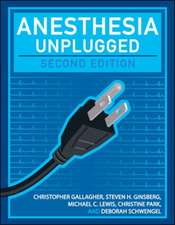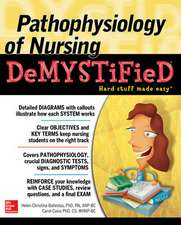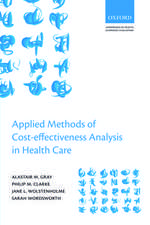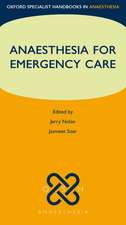Understanding Clinical Data Analysis: Learning Statistical Principles from Published Clinical Research
Autor Ton J. Cleophas, Aeilko H. Zwindermanen Limba Engleză Hardback – 31 aug 2016
In the past few years, theHOW-SOof current statistical tests has been made much more simple than it was in the past, thanks to the abundance of statistical software programs of an excellent quality. However, theWHY-SOmay have been somewhat under-emphasized. For example, why do statistical tests constantly use unfamiliar terms, like probability distributions, hypothesis testing, randomness, normality, scientific rigor, and why are Gaussian curves so hard, and do they make non-mathematicians getting lost all the time? The book will cover theWHY-SOs.
| Toate formatele și edițiile | Preț | Express |
|---|---|---|
| Paperback (1) | 776.06 lei 6-8 săpt. | |
| Springer International Publishing – 14 iun 2018 | 776.06 lei 6-8 săpt. | |
| Hardback (1) | 1098.48 lei 6-8 săpt. | |
| Springer International Publishing – 31 aug 2016 | 1098.48 lei 6-8 săpt. |
Preț: 1098.48 lei
Preț vechi: 1156.29 lei
-5% Nou
210.22€ • 217.17$ • 174.96£
Carte tipărită la comandă
Livrare economică 25 martie-08 aprilie
Specificații
ISBN-10: 3319395858
Pagini: 210
Ilustrații: X, 234 p. 211 illus., 92 illus. in color.
Dimensiuni: 155 x 235 x 16 mm
Greutate: 0.52 kg
Ediția:1st ed. 2017
Editura: Springer International Publishing
Colecția Springer
Locul publicării:Cham, Switzerland
Cuprins
Chapter 1
Randomness
Basis of All Scientific Methods
Chapter 2
Randomized and Observational Research
Writing Protocols, Making Study Data Files
Chapter 3
Randomized Clinical Trials, Designs
Questionable Use of Placebos and Lack of Placebos, Stepped Wedge and Adaptive Designs
Chapter 4
Randomized Clinical Trials, Analysis Sets, Statistical Analysis, Reporting Issues
Principal Features of Statistical Analyses, the Cochrane Risk-of-Bias-Tool
Chapter 5
Discrete Data Analysis, Failure Time Data Analysis
Better Assessments of Biological and Pharmaceutical Agents
Chapter 6
Quantitative Data Analysis
Modeling for False Positive Findings, Using Median Absolute Deviations
Chapter 7
Subgroup Analysis
European Medicines Agency's and American Food Drug Administration's Directives
Chapter 8
Interim Analysis
Alpha Spending Function Approach
Chapter 9
Multiplicity Analysis
Gate Keeping Strategies and Closure Principles
Chapter 10
Medical Statistics, a Discipline at the Interface of Biology and Mathematics
Equating Subjective Feelings with Probabilities, and Providing Quality Criteria for Diagnostic Tests
Notă biografică
The authors are well-qualified in their field. Professor Zwinderman is past-president of the International Society of Biostatistics (2012-2015), and Professor Cleophas is past-president of the American College of Angiology (2000-2002). From their expertise they should be able to choose the best-help-there-is for making difficult issues understandable, that is real data examples from the global literature rather than hypothetical examples.
The authors have been working and publishing together for 18 years, and their research can be characterized as a continued effort to demonstrate that clinical data analysis is not mathematics but rather a discipline at the interface of philosophy, biology, and mathematics.
The authors, as professors and teachers in statistics at universities in The Netherlands and France for the most part of their lives, are convinced, that the scientific method of statistical reasoning and hypothesis testing is little used by physicians and other health workers, and they hope, that the current production will help them find the appropriate ways for answering their scientific questions.
Four textbooks complementary to the current production and written by the same authors are Statistics applied to clinical studies 5th edition, 2012, Machine learning in medicine a complete overview, 2015, SPSS for starters and 2nd levelers 2nd edition, 2015, Clinical Data Analysis on a Pocket Calculator 2nd edition, 2016, all of them edited by Springer Heidelberg Germany.
Caracteristici
Complementarily to real data examples, the book continually gives a philosophical treatise of the basics of the scientific method.
The book explains all of the novel issues of clinical data analysis from the past few years.
Descriere
This textbook consists of ten chapters, and is a must-read to all medical and health professionals, who already have basic knowledge of how to analyze their clinical data, but still, wonder, after having done so, why procedures were performed the way they were. The book is also a must-read to those who tend to submerge in the flood of novel statistical methodologies, as communicated in current clinical reports, and scientific meetings.
In the past few years, the HOW-SO of current statistical tests has been made much more simple than it was in the past, thanks to the abundance of statistical software programs of an excellent quality. However, the WHY-SO may have been somewhat under-emphasized. For example, why do statistical tests constantly use unfamiliar terms, like probability distributions, hypothesis testing, randomness, normality, scientific rigor, and why are Gaussian curves so hard, and do they make non-mathematicians getting lost all the time? The book will cover the WHY-SOs.












